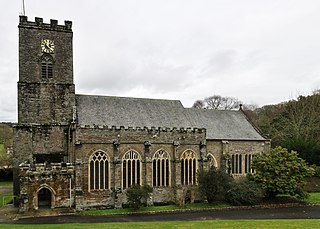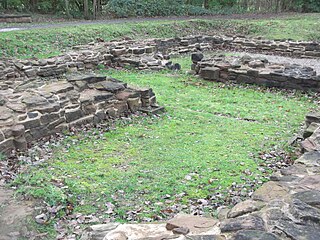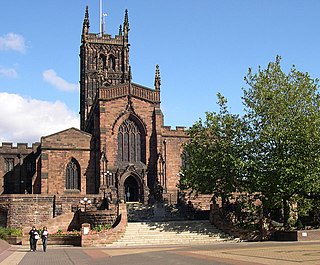
Sir George Gilbert Scott, largely known as Sir Gilbert Scott, was a prolific English Gothic Revival architect, chiefly associated with the design, building and renovation of churches and cathedrals, although he started his career as a leading designer of workhouses. Over 800 buildings were designed or altered by him.

A chapel royal is an establishment in the British and Canadian royal households serving the spiritual needs of the sovereign and the royal family.
In Christianity, a collegiate church is a church where the daily office of worship is maintained by a college of canons, a non-monastic or "secular" community of clergy, organised as a self-governing corporate body, headed by a dignitary bearing a title which may vary, such as dean or provost.

St Buryan is a village and former civil parish, now in the parish of St Buryan, Lamorna and Paul in Cornwall, England, United Kingdom. In 2011 the parish had a population of 1412.
Robert of Shrewsbury was an English cleric, administrator, and judge of the Angevin period. His career culminated in his appointment as Bishop of Bangor.

John Waltham was a priest and high-ranking government official in England in the 14th century. He held a number of ecclesiastical and civic positions during the reigns of King Edward III and Richard II, eventually rising to become Lord High Treasurer, Lord Privy Seal of England and Bishop of Salisbury. He is buried in Westminster Abbey, London.

The Church of St Buryan is a late-15th-century Church of England parish church in St Buryan in Cornwall, England.

William Railton (1800–77) was an English architect, best known as the designer of Nelson's Column. He was based in London, with offices at 12 Regent Street for much of his career.

St Peter's Collegiate Church is located in central Wolverhampton, England. For many centuries it was a chapel royal and from 1480 a royal peculiar, independent of the Diocese of Lichfield and even the Province of Canterbury. The collegiate church was central to the development of the town of Wolverhampton, much of which belonged to its dean. Until the 18th century, it was the only church in Wolverhampton and the control of the college extended far into the surrounding area, with dependent chapels in several towns and villages of southern Staffordshire.

Christianity in Cornwall began in the 4th or 5th century AD when Western Christianity was introduced as in the rest of Roman Britain. Over time it became the official religion, superseding previous Celtic and Roman practices. Early Christianity in Cornwall was spread largely by the saints, including Saint Piran, the patron of the county. Cornwall, like other parts of Britain, is sometimes associated with the distinct collection of practices known as Celtic Christianity but was always in communion with the wider Catholic Church. The Cornish saints are commemorated in legends, churches and placenames.

Sandwell Priory was a small medieval Benedictine monastery, near West Bromwich, then part of Staffordshire, England. It was founded in the late 12th century by a local landowner and was only modestly endowed. It had a fairly turbulent history and suffered considerably from mismanagement. It was dissolved in 1525 at the behest of Cardinal Wolsey – more than a decade before the main Dissolution of the Monasteries under Henry VIII.
Robert de Stretton was Bishop of Coventry and Lichfield following the death of Roger Northburgh in 1358. A client of Edward, the Black Prince, he became a "notorious figure" because it was alleged that he was illiterate, although this is now largely discounted as unlikely, as he was a relatively efficient administrator.

Black Ladies Priory was a house of Benedictine nuns, located about 4 km west of Brewood in Staffordshire, on the northern edge of the hamlet of Kiddemore Green. Founded in the mid-12th century, it was a small, often struggling, house. It was dissolved in 1538, and a large house was built on the site in Tudor and Jacobean styles by the Giffard family of Chillington Hall. Much of this is incorporated in the present Black Ladies, a large, Grade II*-listed, private residence.

Penkridge is a village and parish in Staffordshire with a history stretching back to the Anglo-Saxon period. A religious as well as a commercial centre, it was originally centred on the Collegiate Church of St. Michael and All Angels, a chapel royal and royal peculiar that maintained its independence until the Reformation. Mentioned in Domesday, Penkridge underwent a period of growth from the 13th century, as the Forest Law was loosened, and evolved into a patchwork of manors of greatly varying size and importance, heavily dependent on agriculture. From the 16th century it was increasingly dominated by a single landed gentry family, the Littletons, who ultimately attained the Peerage of the United Kingdom as the Barons Hatherton, and who helped modernise its agriculture and education system. The Industrial Revolution inaugurated a steady improvement in transport and communications that helped shape the modern village. In the second half of the 20th century, Penkridge grew rapidly, evolving into a mainly residential area, while retaining its commercial centre, its links with the countryside and its fine church.

The Dean of Wolverhampton was the head of the chapter of canons at St Peter's Collegiate Church, Wolverhampton, until the chapter was disestablished in 1846. The collegiate church was, until that point, a royal peculiar falling outside of the diocesan and provincial structures of the Church of England. Today, the church is district church within a team parish led by a rector, although it has its own vicar and curate within the team. It is now part of the Diocese of Lichfield.
Henry Lewis Hobart was an English Anglican priest who became Dean of Windsor and thus Dean of Wolverhampton.

St. John's Church is a Grade II* listed Church of England parish church in Wolverhampton.

St Mary's Church, Stafford is a Grade I listed parish church in Stafford, Staffordshire, England.

St Mary's Hospital was a medieval almshouse and chantry in Wolverhampton, associated with St Peter's Collegiate Church. It was founded in the 1390s and disappeared with the abolition of the chantries in the reign of Edward VI. The only vestige today is in the form of a street name.














